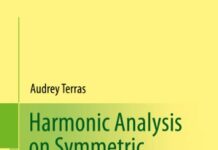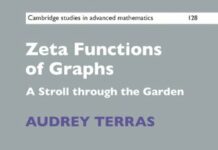
Ebook Info
- Published: 2037
- Number of pages: 456 pages
- Format: PDF
- File Size: 12.45 MB
- Authors: Audrey Terras
Description
This book gives a friendly introduction to Fourier analysis on finite groups, both commutative and non-commutative. Aimed at students in mathematics, engineering and the physical sciences, it examines the theory of finite groups in a manner that is both accessible to the beginner and suitable for graduate research. With applications in chemistry, error-correcting codes, data analysis, graph theory, number theory and probability, the book presents a concrete approach to abstract group theory through applied examples, pictures and computer experiments. In the first part, the author parallels the development of Fourier analysis on the real line and the circle, and then moves on to analogues of higher dimensional Euclidean space. The second part emphasizes matrix groups such as the Heisenberg group of upper triangular 2×2 matrices. The book concludes with an introduction to zeta functions on finite graphs via the trace formula.
User’s Reviews
Reviews from Amazon users which were colected at the time this book was published on the website:
⭐The book presents a wealth of facts regarding finite structures related with the Fourier transform and its many applications – not only the usual stuff on fast and discrete Fourier transforms (FFT/DFT), but also on Cayley graphs, error-correcting codes, group representation, and the Selberg trace formula, among other things, e.g., an introduction to the idea of random walks on groups. However, while I liked the choice of subjects and the book ‘hits the point’ many times, sometimes you get lost in the somewhat sketchy presentation, as if it had been assembled directly from slide presentations and lecture notes. The book also has some typos like non-matching parentheses, spacing errors, and dislocated super- and subscripts, most of them harmless.Dr. Terras is a good math writer, though, and succeeds in making an otherwise potentially dull subject entertaining, either by demonstrating erudition – she cross-references ideas from different fields with apparent ease – or by interspersing her book with wit. For example, in chapter 15 (p. 243) we read that “A chapter of a mathematics book often begins with a long parade of definitions. Sorry, but it appears that we are at the beginning of a chapter.” Fine.I recommend the excellent and highly entertaining “Number Theory in Science and Communication,” by Manfred R. Schroeder, as companion reading. In Schroeder’s book you will find a more structured (perhaps more elementary) presentation of a large subset of the subjects presented by Terras.My rate: 5 stars for the innovative choice of topics and quality of the math and -1 star for the sketchy presentation. This book deserves a better editorial and typographical treatment (e.g., the type chosen to represent the Cyrillic letter shah is a shame, some figures seem to have been extracted from shabby PowerPoint slides, etc.) as well as a hardcover in a future, ideally updated, edition.
⭐For downtime at the office!
⭐For students and users who need the facts! Perhaps they havecome accross a group problem in programming, in physics, in some course or other, or in a research assignment. Over the years, when teaching, I am often asked by students for directions to the facts of groups(usually finite) and their harmonic analysis.And too often, I have had to send the poor studentto a multi-volume book set on the general theory. Sure much of it can be specialized to what the case demands. But the user[in e.g., programming, algorithms, fast transforms, error-correction codes, crystals, symmetry, quantum theory, engineering…]typically isn’t ready for the big picture yet, and more often than not, she will need to first look for a gentle introduction–just the facts!– and written in a delightful style! The one that this author has perfected in her other books. Thanks! Now I do feel good about sending my students to this lovely little book. Great book! — And gentle on my student’s budget too.
⭐This is a delightful book that covers broad areas of theoretical and practical mathematics from the standpoint of Group Theory and Fourier Analysis. Although Fourier Analysis is first in the title, I think Finite Groups should come first. The author takes the discrete perspective of traditionally continous functions of classical physics and other applications – which not suprisingly brings finite groups into the picture. This includes the applications of quadratic residues and primitive roots to areas not usally touched by number theory – such as the ceilings of concert halls. This is a fun book, and it doesn’t pretend to be comprehensive or complete with regards to its choosen subjects. I’d call the book “A Grand Tour of Finite Groups and Fourier Analysis with Applications” if I were the publisher. The price is suprisingly affordable given the subject where new books usually cost O($100).
Keywords
Free Download Fourier Analysis on Finite Groups and Applications (London Mathematical Society Student Texts Book 43) in PDF format
Fourier Analysis on Finite Groups and Applications (London Mathematical Society Student Texts Book 43) PDF Free Download
Download Fourier Analysis on Finite Groups and Applications (London Mathematical Society Student Texts Book 43) 2037 PDF Free
Fourier Analysis on Finite Groups and Applications (London Mathematical Society Student Texts Book 43) 2037 PDF Free Download
Download Fourier Analysis on Finite Groups and Applications (London Mathematical Society Student Texts Book 43) PDF
Free Download Ebook Fourier Analysis on Finite Groups and Applications (London Mathematical Society Student Texts Book 43)


